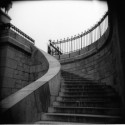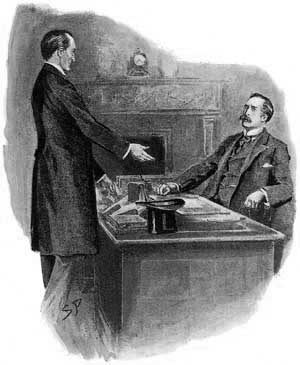A Scion Society of The Baker Street Irregulars

The 17 Steps: The Empty House
Seventeen thoughts for further ponderance of the case at hand – The Empty House (EMPT)

JOHN H. WATSON, CRIME DOCTOR
“And I even attempted, more than once, for my own private satisfaction, to employ his methods in their solution, though with indifferent success.”
Without Holmes, Watson would have us believe that his entire contact with crime came via the newspapers. But could he truly try to use Holmes’s methods only using the information supplied by the papers? Is Watson covering up some actual scene-of-the-crime investigations he attempted in Holmes’s absence?
THE ENGLAND/AUSTRALIA MEDICAL DIFFERENCE
“Adair’s mother had returned from Australia to undergo the operation for cataract.”
What was the state of available medical services in Australia at the time? Was cataract surgery a specialty available only in the city of London? Even at that, was the surgery a very successful procedure in 1894?
THOSE ARE SOME REALLY GREAT NEWSPAPERS
“All day I turned these facts over in my mind, endeavouring to hit upon some theory which could reconcile them all …”
The facts that Watson refers to in the paragraphs before that line are quite detailed: the crocuses by the house are in bloom, the money next to the murdered man is detailed by denomination … did reporters accompany police to crime scenes in those days? Or is Watson embroidering the details from the newspaper for his readers’ benefit?
THE MYSTERIOUS BOOKSHOP
Watson’s visitor, the little old bookman, says, “I am a neighbour of yours, for you’ll find my little bookshop at the corner of Church Street, and very happy to see you, I am sure.”
If the corner of Church Street was in Watson’s neighborhood, wouldn’t he have noticed a bookstore there? Well, maybe not. But was there really a book store there that the “bookman” used to back his story? Or was this a flaw in his mask that Watson was supposed to catch? Would he have expected Watson to be familiar with the interior of a bookstore in his neighborhood, or did he claim ownership confident in the knowledge Watson had never been inside it?
THE STRUCTURE OF WATSON’S LIBRARY
The bookman also tells Watson: “With five volumes you could just fill that gap on that second shelf. It looks untidy, does it not, sir?”
Watson then writes: “I moved my head to look at the cabinet behind me.” Watson is in his study — what sort of cabinet would a Victorian doctor keep his books in? And would these have been Watson’s medical books, recreational reading, or something a little more valued? Is Watson’s reaction (looking at the shelf space first, not the books) a sign that the doctor was no bibliophile?
DIAGNOSING WATSON’S SWOON
“… it appears that I must have fainted for the first and the last time in my life. Certainly a gray mist swirled before my eyes …”
Do people really see gray mists before their eyes when they’re passing out? Wouldn’t one see colored flashes of some sort? Or possibly blackness? Does this gray mist tell us anything about Watson, like perhaps he’s color-blind?
THE RETURN OF SHERLOCK HOLMES
“Holmes!” Watson cries, “Is it really you? Can it indeed be that you are alive? Is it possible that you succeeded in climbing out of that awful abyss?”
You have to love moments like this. Watson (a doctor) is stunned enough to ask the man in front of him if he’s alive. His first thought is that this man he has portrayed in superhuman terms so many times actually fell into the abyss, and then spent three years climbing back out again. While the doctor gets the full story very soon, this moment and that vision make one wonder: how much did Watson see his friend as a legendary figure, the sort of man who not just survives a fall from a cliff, he climbs back up the cliff-face to show it hasn’t beaten him? Is mythologizing one’s friends a healthy thing to do? Or did Holmes just amaze Watson so often that he couldn’t help such a viewpoint?
WATSON’S BEEN TALKING TO HIS AGENT
“Well, you’re not a spirit, anyhow,” the good doctor comments after feeling Holmes’s “thin, sinewy arm” With all Watson’s questions, one has to wonder why Watson didn’t trust his eyes. Had he had some encounter with the spirit world in his time apart from Holmes? With Holmes’s death and Watson’s “recent bereavement,” would we expect Watson to turn to a medium? Was Holmes’s later comment, “No ghosts need apply,” directed at a particular pet belief of Watson?
HOLMES’S HARD LIFE IN FRANCE
“Holmes looked even thinner and keener than of old, but there was a dead-white tinge in his aquiline face which told me that his life recently had not been a healthy one.”
Wait a minute … Holmes later says his most recent activities were spending “some months in a research into the coal-tar derivatives, which I conducted in a laboratory at Montpellier, in the south of France.” The sunbelt of France? With Mediterranean beaches not all that far away? There have even been theories tossed about that he had family there, so why is Holmes so unhealthy-looking?
WATSON’S HIDDEN SADNESS
“In some manner he had learned of my own sad bereavement, and his sympathy was shown in his manner rather than in his words.’Work is the best antidote to sorrow, my dear Watson,’ said he.”
How long before this case would we guess Watson’s sad event took place? Would Holmes be making his “antidote” comment if it were more than six months prior? Or was it fresh enough to be the unspoken reason for Holmes’s return? Does Watson’s fresh interest in a criminal case hold any clues?
HANSOMS, GUNS, AND THRILLS
“It was indeed like old times when, at that hour, I found myself seated beside him in a hansom, my revolver in my pocket, and the thrill of adventure in my heart.”
While Watson’s chronicles are full of non-criminal cases, Holmes was a specialist in crime. On what percentage of Holmes’s cases did Watson carry a gun? How big a part of “feels like old times” was Watson packing heat? Did he need a gun more often than the Canon would seem to indicate?
DID THEY GET THE STRAND MAGAZINE IN TIBET?
“Might I trouble you, my dear Watson, to draw a little nearer to the window, taking every precaution not to show yourself, and then to look up at our old rooms–the starting-point of so many of your little fairy-tales?”
At the time Holmes disappeared into his travels, Watson had only published two of his “fairy-tales.” All of the Adventures and Memoirs came out while Holmes was in Asia and Europe (most while he was in Tibet). How was it Holmes got to read Watson’s tales? Did they have them in France by the end of 1893? Might Holmes have first read them in French? A second sign Holmes had not only read, but remembered Watson’s works, enough to almost follow one of Watson’s title conventions: “We have three years of the past to discuss. Let that suffice until half-past nine, when we start upon the notable adventure of the empty house.”
PRIME BAKER STREET PROPERTY GOING TO WASTE
“The place was pitch dark, but it was evident to me that it was an empty house. Our feet creaked and crackled over the bare planking, and my outstretched hand touched a wall from which the paper was hanging in ribbons … the window was thick with dust …”
The general impression we get of Camden House is one of a long-vacant house, of the sort neighborhood kids always consider haunted. What sort of neighborhood was Baker Street in those days, and would we expect to find a completely vacant house there? Why would a house in the center of London sit empty so long as to get a coating of dust on the windows?
AND WHAT OF 221B BAKER STREET?
If Camden House wasn’t in bad enough shape, next Holmes is describing 221B as “that picturesque pile.” Good thing Holmes isn’t running a real estate open house for his old digs. Of what age would we expect the house at 221 to be, and in what state of repair? Holmes is no pauper — if he truly thought of 221 as a “pile” why didn’t he move?
HOLMES’S OTHER FRENCH DIVERSION
Of Holmes’s wax twin, he says, “The credit of the execution is due to Monsieur Oscar Meunier, of Grenoble, who spent some days in doing the moulding.”
Holmes was obviously planning his trap for Colonel Moran long before he left France, knowing that the Colonel was his main impediment in returning to his life of old. How did Moran stay free when the rest of Moriarty’s gang was convicted? Holmes knew of Moran and his air-gun in 1891. Was he fleeing Moran when he went to Tibet? Why would he take three years to get up the guts to come back and catch Moran, a man he knew was a killer in 1891? Does the blame for Ronald Adair’s death fall partially on Holmes’s reluctance to return earlier? Or did it just take three years for Oscar to mold that dummy?
And while we’re at it, of Moran we hear: “Moriarty supplied him liberally with money, and used him only in one or two very high-class jobs, which no ordinary criminal could have undertaken. You may have some recollection of the death of Mrs. Stewart, of Lauder, in 1887. Not? Well, I am sure Moran was at the bottom of it, but nothing could be proved.” Holmes actually traced a crime from 1887 to Moriarty and Moran, and still couldn’t catch the assassin until seven years later?
IGNORE THAT HARMLESS MAN WITH THE GARROTE
“He is a harmless enough fellow, Parker by name, a garroter by trade, and a remarkable performer upon the jew’s-harp.”
Was a garroter necessarily a mugger and not a murderer, as some Sherlockians would have us believe? Choking someone into insensibility is an inexact science. One probably kills a few victims before one truly gets the “hang” of it. And heck, once one had killed someone accidentally, why not take out a victim or two for a price? Why would Holmes consider Parker so harmless?
THE SOURCE OF THE INFAMOUS AIR GUN
Holmes admits: “I knew Von Herder, the blind German mechanic, who constructed it to the order of the late Professor Moriarty. For years I have been aware of its existence, though I have never before had the opportunity of handling it.”
The detective was obviously aware of the gun back in 1891. Might Von Herder have been a London acquaintance of Holmes’s who helped put him on to the Professor’s track? Does “I knew Von Herder” imply a relationship before the Moriarty investigation?

The Seventeen Steps originally appeared on the Hounds of the Internet e-list from September 2000 to October 2001 and later on the Sherlock Peoria blog.
Brad Keefauver, the 41st Garrideb, is the author of The Elementary Methods of Sherlock Holmes, Sherlock and the Ladies, and The Armchair Baskerville Tour. Former publisher of The Holmes & Watson Report, The Dangling Prussian, and a whole lot of obscure, collectable little things on our boy Sherlock. Keefauver is a member of the Baker Street Irregulars and the Adventuresses of Sherlock Holmes.

Sorry, comments are closed for this post.